One of the most common questions I get is, “are locking tuners worth it?” The simplest answer is “sometimes.” In this article, I’ll tell you exactly when to use locking tuners and when it’s not worthwhile.
Keep reading to learn more!
You can use the table of contents below to take you to the area that interests you. Click on the little box to open it and then click on the section of the article you want to read, or you can read from start to finish if you want the full locking tuner experience!
The Short Answer
Locking tuners are most worthwhile when your guitar has a non-double-locking tremolo bridge, especially if you are an aggressive whammy bar user. Even if your guitar already stays in tune, locking tuners will still make string changes easier and quicker. If you can afford the additional cost, locking tuners are worth it.
Keep On Reading (Below) To Learn More
What Are Locking Tuners?
A locking tuner is designed to “lock” a guitar string in place by threading it into the tuning post and immobilizing it with a pin (or piston) that is moved up and down by a thumb wheel. This prevents the need for winding the string around the tuning post to secure it.
Here is an image that shows the location of the thumb screw and the locking pin that holds the string in place.
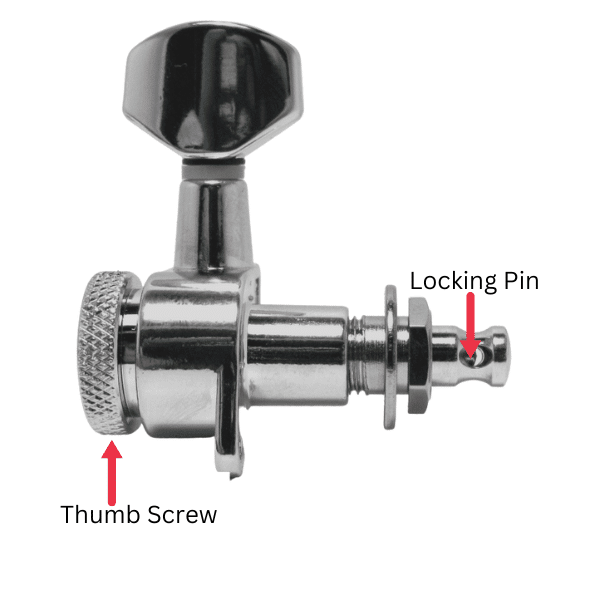
Traditional tuning machines can allow string slippage, especially during string bends using the fingers or a whammy bar. The locking tuner does not require the string to be wrapped around the end of the tuning post, which is what gives it tuning stability.
This is because multiple windings on the tuning post can loosen and shift to a different position when the string tension is changed with a whammy bar.
Locking Vs. Traditional Tuner Comparison

Here’s how locking tuners compare to traditional tuners on electric guitars.
| Comparison | Locking Tuners | Traditional Tuners |
|---|---|---|
| Tuning Stability | Better | Worse |
| String Changes | Easier and quicker | More time consuming |
| String Winding | Minimal or none | Multiple windings required |
| String Appearance | Neater | Messy |
| Bridge | Better for tremolo bridge | Work ok with hardtail bridge |
| Installation | More Difficult | Easier |
| Need String Tree | No (if tuners are staggered) | Yes |
| Weight | Heavier | Lighter |
| Cost | More | Less |
Keep On Reading (Below) To Learn More About Each Topic
Advantages Of Locking Tuners

Tuning Stability
Improved tuning stability is the biggest advantage of locking tuners! They work so well because the strings don’t slip on the tuning posts.
If your guitar is having tuning issues and you’re sure the tuning machines are the culprit, locking tuners are probably your best bet, assuming it doesn’t have a double-locking tremolo (more about this later).
String Changes
String changes are a breeze with locking tuners. Once you get used to how quick and easy it is, you’ll probably never want to buy a guitar without them, especially if you go through string sets quickly.
In a performance situation, you can usually get back up and running quickly if you accidentally pop a string.
String Winding And Appearance
How you wind your strings on their tuning machines can be critical for keeping your guitar in tune.
When I first started playing, I thought winding the entire string on the tuning post would give it more stability. I had a lot of crazy ideas as a kid, and this was one of them.
The more string winds you have, the least likely the string will stay in tune, especially if they are an overlapping mess like the photo on the right (below)! If you use traditional tuners, don’t be a victim of the messy string setup.
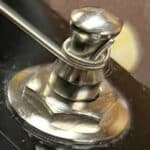
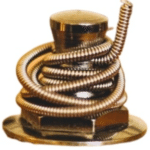
Now, check out how the strings look on my Strat’s locking tuners in the photo below. The strings do not wind around the post, so string slippage is not possible! This is what makes locking tuners so great at helping to keep your guitar in tune!
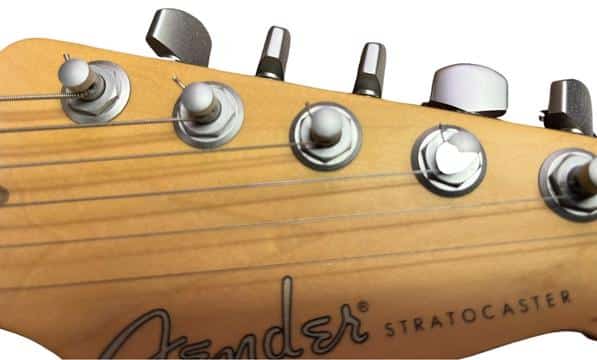
You may end up with the string wrapping once around the post as you tune it, but that’s fine.
String Tree Not Required
With locking tuners you don’t need a string tree to put downward pressure on the B and high-E strings, assuming they are a staggered (6-inline) set of tuners, like on a Strat.
With staggered locking tuners, the tuning posts on the first three (E, A, and D strings) are taller than the posts on the last three (G, B, and E strings), so they exert enough downward pressure to eliminate the string tree.
Work Better With A Tremolo Bridge
Locking tuners work much better with a tremolo bridge (non-double-locking) than with a hardtail (non-tremolo) bridge.
If you use locking tuners on a guitar with a tremolo bridge, it’s best to also use a lubricated nut, like a TUSQ XL. You can check out the reviews and prices of TUSQ nuts on Amazon by clicking HERE.
Lubricated nuts work great at helping to keep your guitar in tune because they prevent the strings from getting bound up when tuning or bending strings, especially when using the tremolo bar.
Disadvantages Of Locking Tuners

Installation
Installing locking tuners requires the proper tools and training since the tuning post hole may need to be widened and additional holes may need to be drilled into the headstock.
If you are inexperienced or don’t have the proper tools, I recommend you take your instrument to a certified guitar tech or luthier.
Weight
Locking tuners tend to be a little heavier (up to one ounce) than traditional tuners. The bigger, 3×3 configuration locking tuners weigh more than the smaller 6 in-line tuners.
Depending on the guitar, some players find that locking tuners can throw off the balance of their instrument a bit.
It’s hard to tell if this will happen to you and if it will be enough to make a difference when you play your guitar in the standing position. Usually, you can compensate for the weight difference by adjusting your guitar strap or trying a different one.
In the big picture, it’s not a significant problem.
Cost
High-quality locking tuners do tend to cost more than traditional ones. The cost differential is not usually significant enough to be prohibitive. If it fixes an issue with tuning stability, it’s well worth the extra money.
Will Locking Tuners Always Fix A Tuning Problem?
No, changing your traditional tuners to licking tuners won’t always guarantee fixing a tuning problem.
The problem with the tuning could be caused by the following issues:
Bad Tuning Machines Plus Some Other Problem(s)
Installing locking tuners won’t completely solve your tuning problem if there is also something else affecting the guitar’s tuning. Some of these other problems are listed below.
The String Tree
If you have a guitar with a string tree, it could be binding the strings and putting them out of tune, especially if you are an aggressive whammy bar user. You may need to replace it with graphite string trees.
If you are installing locking tuners, you won’t need the string tree if they will have staggered tuning pole heights.
The Nut
Guitar nuts are a very common cause of tuning problems. If the nut slots are not cut correctly or if there is a lot of friction in the slots, it can bind the strings, especially when using a whammy bar.
You can try lubricating the nut slots with graphite or with a pencil. If that doesn’t solve the problem you can have the nut slots properly cut or replace it with a self-lubricating nut.
The Frets
Frets that are worn down or improperly crowned can cause tuning and intonation problems. Re-crowning or replacing frets can be an expensive proposition, so be sure that this is not a contributing factor before investing in locking tuners!
Neck Bow Or Back-Bow
A neck that is out of alignment (bowed or back-bowed) can cause tuning or intonation problems. Things like temperature changes and changing to a bigger or smaller string gauge can cause a guitar neck to shift out of proper alignment.
The truss rod can be adjusted to correct this problem, but don’t attempt it if you don’t have the proper tools or experience. You could permanently damage your guitar.
Pickup Height
If the pickups are set too close to the strings, the magnetic string pull can cause problems with tuning and intonation. Set the pickup height at the “sweet spot” to give you the best sound, not as high up as possible to provide you with the most volume!
Bridge And Saddles
The bridge on a tremolo guitar must be set at the correct height and angle to avoid tuning problems. It’s also essential to adjust the bridge saddles correctly, or the intonation will be off.
Does One Size Locking Tuner Fit All Guitars?
No, locking tuners come in more than one size and configuration. It’s essential to get the right tuners to fit your guitar.
As shown in the photos below, locking tuners come in two basic configurations to accommodate various styles of electric guitars.
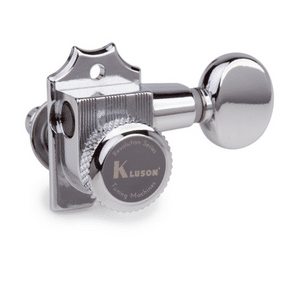

The smaller 6 in-line locking tuners are for guitar headstocks with all the tuners on one side, like a Fender Strat or Tele. There are larger locking tuners for guitars like a Gibson Les Paul or an SG to accommodate headstocks with three tuners on each side (a 3×3 configuration).
Do Locking Tuners Improve Resale Value?
It’s difficult to say definitively what effect adding locking tuners to your guitar will have on resale value, but here are some general guidelines.
Low-End (Cheaper) Guitars
It’s doubtful that adding locking tuners will improve the retail value of guitars in this price bracket. The cost of the tuners could exceed what the guitar is actually worth.
If you love the guitar and it won’t stay in tune, you might want to invest in new tuners to solve the problem, even though you won’t get your money back.
Please don’t be offended; I’m not calling your guitar “cheap,” I’m speaking strictly from a business point of view. I still have the first guitar I ever bought from Sears in the 1960s, and I wouldn’t trade or sell it for anything.
Middle To High-End Guitars
This is where it becomes a gray area and depends on your thinking and the individual guitar. If locking tuners are professionally installed, and the result is cosmetically acceptable, they could increase the guitar’s retail value.
It’s unlikely that locking tuners would detract from the guitar’s worth at the point of sale. If you plan on installing them yourself, ensure you have the proper tools and training to do it correctly.
Vintage Guitars
If you have a high-value vintage guitar, the last thing you would want to do is slap a set of locking tuners on it. Even if you save the original parts, any permanent modifications, such as drilling new holes, would significantly lower the instrument’s retail value!
If the tuners don’t stay in tune, have them looked at by a certified guitar tech or luthier. Most likely, they can be repaired. They just may require proper lubrication. The tuning problem may stem from a totally different issue, which can be resolved with a proper guitar setup.
If you’re not sure what your “vintage” guitar is actually worth, the first thing to do is to have it evaluated by a professional vintage guitar dealer that can give you an honest and accurate price range.
Locking Tuners Vs. Locking Nut – Which Is Better?
The choice between installing locking tuners vs. a locking nut depends on the individual guitar and how you will play it. Before doing anything, always perform a complete setup on the guitar to check for other things that need to be adjusted or addressed!
Guitars Without A Tremolo Bridge
For guitars without a tremolo bridge (no whammy bar), locking tuners are to way to go. A locking nut would be overkill.
After installing the locking tuners, if you still find that your strings are going out of tune, especially with finger string bends or vibrato, it may be a problem with the nut. Lubricating the nut slots or installing a self-lubricating nut should solve the problem.
Guitars With A Tremolo Bridge
Standard Tremolo Bridge
For guitars with a traditional bridge tremolo, like a Stratocaster, I usually recommend locking tuners and maybe a self-lubricating nut if the whammy bar is to be used aggressively.
Double-Locking Bridge
Double-locking bridges lock the strings at the bridge and the nut, so there’s no need for locking tuners.
Most aftermarket double-locking Floyd Rose-type bridges come with a locking nut, which needs to be installed in place of the traditional nut.

Kahler double-locking systems lock the strings at the bridge and behind the nut. If you install a Kahler, I recommend using the locking nut as intended and changing the traditional nut to one that is self-lubricating (graphite-based), like a TUSQ nut.
Here is a photo of my Ibanez RGT 42MDX. It has a Floyd Rose-licensed bridge with a locking nut. This double-locking bridge setup works great with traditional tuners. It never goes out of tune, even with radical divebombs!

Here are front and back photos of the locking nut up close.
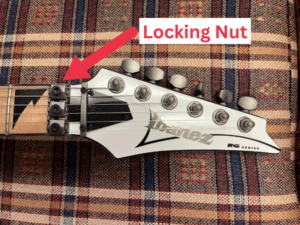
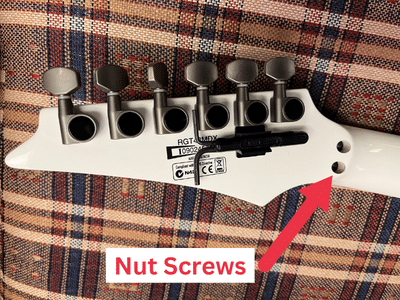
As you can see, the locking nut is screwed to the guitar through holes in the back of the neck. Don’t try installing the locking nut on your guitar unless you really know what you’re doing and have the proper tools!
Can You Use A Double Locking Bridge Without The Locking Nut?
The answer is yes, but the tuning won’t be as stable.
Here is one of my Strats that was fitted with a Kahler double locking system. Unlike the Floyd Rose bridge, which uses a knife edge, the Kahler bridge works with a cam.

Kahler systems use a locking nut behind the traditional nut, so it’s essentially a two-nut system.
This guitar had the locking nut removed from its position behind the traditional nut. The traditional nut was replaced with a graphite nut, and the tuners were upgraded to locking tuners.

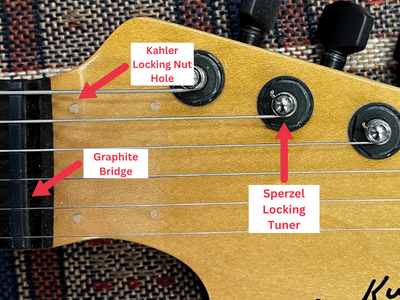
The guitar plays great and stays in tune really well. Repeated divebombs can throw it out of tune a bit, but for the way I play, it works fine.
By the way, in case you’re wondering, those are the early generation Seymour Duncan Hot Rails with the curved tops. A mini toggle switch (hidden under the tremolo arm in the top photo) turns on the neck and bridge pickups. Phillip Kubicki made the neck. It has a 15-inch fingerboard radius with jumbo Dunlop frets.
My Favorite Locking Tuners

I’ve used these locking tuners on many guitar builds and mods. I like them because they work great and are reasonably priced!
You may have to modify your guitar’s headstock to make them fit, and some tuners won’t work correctly on certain angle headstocks, so always be sure before you buy.
6-In-Line Locking Tuners
These are designed to fit on guitars with the tuners all on one side, like Fender Strats and Teles. They are smaller than the 3×3 locking tuners.
Fender Deluxe Locking Staggered Guitar Tuners
These locking tuners have an 18:1 gear ratio and staggered tuning posts (3 long and 3 short). They come in polished chrome, black, brushed chrome, and gold. I prefer brushed chrome, which looks really sharp with a brushed chrome roller nut and bridge saddles!
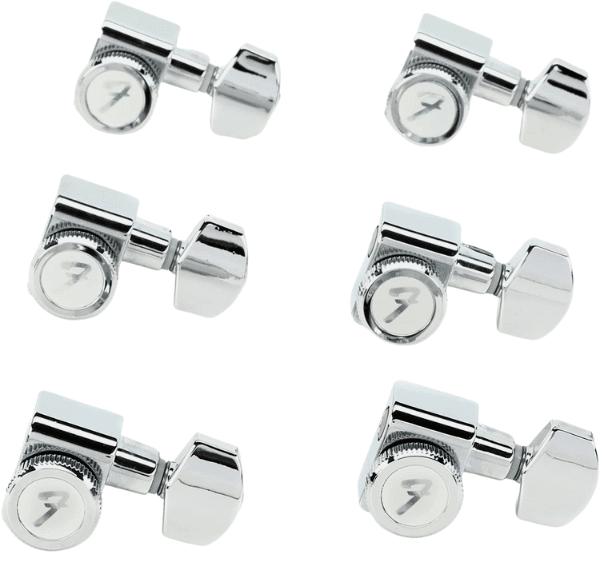
Click HERE To Check Reviews & Price On Amazon
Guyker Locking Tuners
These locking tuners are a bit more of a budget option. They have an 18:1 gear ratio and are well-made with a smooth-turning heavy-duty gear mechanism. They’re available in chrome.
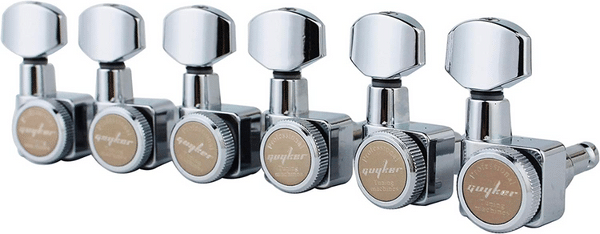
Click HERE To Check Reviews & Price On Amazon
3×3 Locking Tuners
Wilkinson Locking Tuners
These Wilkinson tuners have a 19:1 gear ratio. I’ve installed these tuners on several Gibson guitars, and they look and work great! They come in chrome, black, and gold.

Click HERE To Check Reviews & Price On Amazon
Guyker Vintage Style Locking Tuners
These locking tuners are an excellent choice if you’re looking for that “Gibson vintage” look. They have the classic 1:15 gear ratio and come in Chrome, Nickel, Black, and Gold.
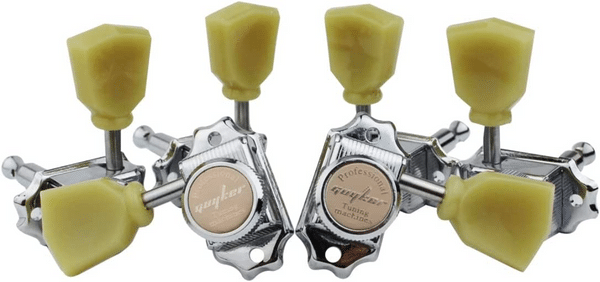
Click HERE To Check Reviews & Price On Amazon
Beware Of Tuner Size And Orientation

All tuning machines are not equal or interchangeable. They come in different sizes and orientations. Some are designed for a 6 in-line configuration (e.g., Strat or Tele), while others are 3×3 (e.g., Les paul or SG).
Tuners can be purchased for right-handed and left-handed guitars.
Some tuners will not correctly fit on headstocks with a certain angle.
It’s common to need to modify the guitar to enlarge the tuning post hole or drill new holes to anchor the tuner.
Are You Qualified To Make Guitar Adjustments Or Modifications?
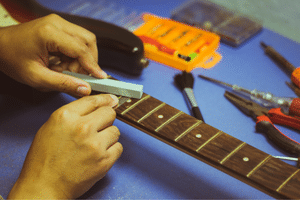
It’s great to work on your guitars, especially if you have a lot of them, but you should always be aware of your limitations.
Adjusting things like an electric guitar’s string height (action) or pickup height can be straightforward. Still, some adjustments require the proper training and experience, like adjusting a guitar’s truss rod.
Installing locking tuners may require special tools and training.
When you doubt your ability to adjust, repair, or modify your guitar, it’s always best to bring it to a competent guitar technician or luthier (guitar designer & builder). You can permanently damage your guitar, and it might never play and sound right again!
Making modifications to your guitar can void its manufacturer’s warranty and cause permanent damage to the instrument. Certain modifications are irreversible, so you may be stuck with them, even if you desperately want to restore the guitar to its original condition!
I learned that the hard way over the years until I did a three-year apprenticeship in a guitar repair shop. Now I have my own home workshop with the proper training and equipment to safely maintain and repair all my instruments.
Remember: “When In Doubt, Send It Out!”
Frequently Asked Questions

Here are some of the questions I get asked about locking tuners.
If your question does not appear here, please put it in the comments, and I will get right back to you with an answer.
How Tight Should You Tighten Locking Tuners?
I find that most people tend to overtighten locking tuners. Tighten the thumbwheel until the locking pin touches the string, and then just a “tiny bit” further. If you turn the thumbwheel too far, you could bend the pin and break the tuner!
Do You Have To Wind Locking Tuners?
No, the point of locking tuners is that you don’t have to put extra string windings on the tuner post. The more windings you have, the more likely they will loosen and move with aggressive whammy bar use. One winding around the tuning post is ok.
Do You Leave Slack With Locking Tuners?
No, it would be best if you didn’t leave the string slack when using a locking tuner. Pull the string through the tuning post hole until it is taut (tight). Leaving slack in your string could result in extra windings on the tuning post.
Can You Drop Tune With Locking Tuners?
Yes, you can drop tune with locking tuners, but you must have extra string winding on the tuner posts. If you have a floating whammy bar and drop one string’s pitch, all the other strings will go sharp.
If you have a decked or blocked tremolo bridge, you will only need extra tuner post winding on the string(s) that will be dropped. For example, if you use dropped D tuning, you only need additional winding on the low-E string.
Can You Put Locking Tuners On A Strat?
Yes, you need to get the proper 6 in-line locking tuners that are the closest fit to your model Strat. You may have to modify the headstock by driving extra holes.
3×3 Locking tuners are made to put three tuners on one side of the headstock and three on the opposite side, like for a Gibson guitar. These tuners are bigger than the 6 in-line Strat tuners.
Do You Need To Stretch Strings With Locking Tuners?
Yes, absolutely! You should always hand-stretch a new set of strings, regardless of what type of tuners your guitar has. Stretching new strings helps them stay in tune.
Final Thoughts

So, after reading this article, what do you think? Are locking tuners worth it?
Locking guitar tuners have no real advantage on a guitar with a double-locking tremolo, in which the strings are locked at the nut, such as a Floyd Rose system.
Lock tuners work best on a guitar with a non-locking tremolo bridge, such as a Stratocaster, especially if you have a floating bridge and use the whammy bar aggressively. Lubricating your guitar nut with graphite or installing a self-lubricating nut or roller nut can further improve the performance of your tuning stability.
If you have an electric guitar with a hardtail bridge locking tuners will not improve tuning stability, but they will make it easier and quicker to change strings because you don’t wrap them around the tuning posts.
Not all locking tuners are the same size and configuration. 6 in-line locking tuners are for headstocks with the tuners all on one side. like a Fender Startocaster or Telecaster. 3×3 locking tuners are larger than 6 in-line tuners and fit guitars with headstocks that have three tuners on each side, like a Gibson Les Paul or SG.
Your guitar’s headstock may require modification to install the locking tuners correctly. If you don’t have the proper tools and training, take it to a certified guitar tech or luthier.
Before installing locking tuners on your guitar, it’s a good idea to evaluate the instrument to ensure another issue is not causing a problem with tuning or intonation.
Installing locking tuners may or may not increase your guitar’s resale value, depending on the instrument’s make, model, year of manufacture, and overall condition.
If you have a double-locking tremolo with a locking nut, installing locking tuners is not recommended because they will not improve your tuning stability.

Changing Strings With Locking Tuners
Check out this video to see how Trey Xavier from Guitar Gods changes the strings on his 7-string guitar with locking tuners. The trick is not to overwind the string on the post!
Related Article ➡ How To Keep An Electric Guitar In Tune
Tell Me What You Think

Please leave a comment below if you enjoyed this article, have any questions about locking tuners, or want to give your point of view. I will be happy to help you.
- What do you think about locking tuners?
- Would you put locking tuners on your guitar?
- Did you know the proper way to use locking tuners?
- What else is on your mind?

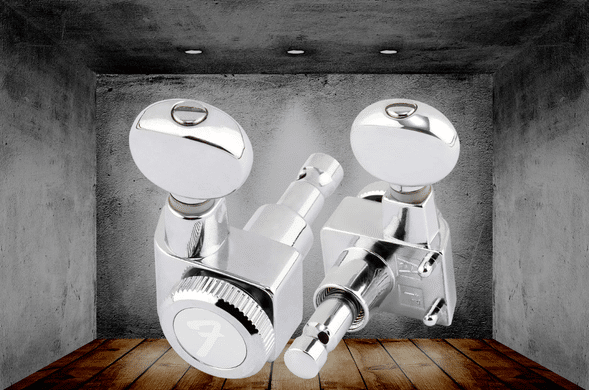

Wow. What a great post; thank you for sharing “Are Locking Tuners Worth It? – An Eye-Opening Assessment!”. This is probably the best post I have seen in a long time. Great explanations and significant comparisons; I know precisely what it is now. I enjoyed reading this post, and thank you for spending time writing it.
Have a great day.
Regards
Vlad
Hi, Vlad
You’re welcome!
I hope it helps you with any future decisions regarding locking tuners.
Best,
Frank 🎸
For me I think locking tuners are worth it in every aspect. The innovation has made tuning easier and faster unlike the traditional tuners. Musicians can understand the stress and pain of winding a guitar strings in the process of tuning it at the end it comes out rough and bad but with the use of a locking tuner all that error can be avoided
Hi There
Thank You for your comments, and I agree with you!
I use locking tuners on all the guitars I build that have non-locking tremolo bridges for tuning stability and on some with fixed bridges for restringing convenience.
Frank 🎸
One problem I notice with the fender locking tuners on my American Special Telecaster is the D string has less break angle over the nut, it may be no problem but it may affect the tone of wound strings.
Hi, Mike
That’s an interesting observation!
If it becomes really noticeable, you can always shim the D-string locking tuner from the back of the headstock, just a slight amount.
Please let me know how you make out.
Rock On! ?
Frank ?